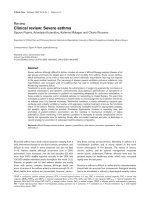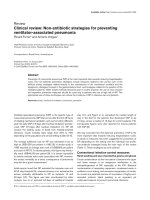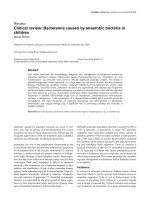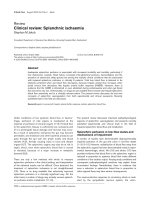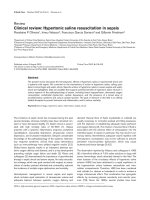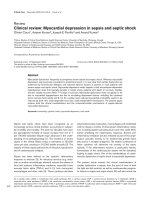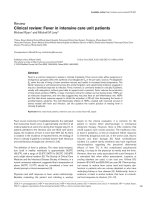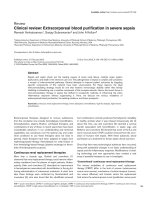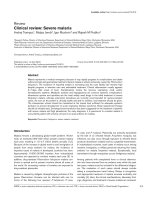Báo cáo y học: "Clinical review: Non-antibiotic strategies for preventing ventilator-associated pneumonia" pps
Bạn đang xem bản rút gọn của tài liệu. Xem và tải ngay bản đầy đủ của tài liệu tại đây (59.46 KB, 7 trang )
ICU = intensive care unit; NP = nosocomial pneumonia; VAP = ventilator-associated pneumonia.
Available online />Ventilator-associated pneumonia (VAP) is the specific type of
nosocomial pneumonia (NP) that occurs after the first 48 hours
of initiating mechanical ventilation, and can be further differenti-
ated into early VAP (< 5 days after tracheal intubation) and late-
onset VAP (> 5 days after tracheal intubation) [1]. NP still
remains the leading cause of death from hospital-acquired
infections. Crude mortality rates range from 24% to 76%
depending on the population and clinical setting studied [2–5].
The average additional cost for NP was estimated to be as
high as US$1255 per patient in 1982 [6]. A similar study in
1985 reported an average extra cost of US$2863 per patient
and case of NP [7]. In trauma patients, this figure may eventu-
ally reach US$40,000 per patient [8]. It is almost impossible
to directly evaluate extra costs associated with NP; however,
the excess morbidity as a direct consequence of pneumonia
may also be a good measurement.
Initial reports found that NP extended the intensive care unit
(ICU) stay threefold [9], whereas Jimenez et al. estimated the
excess morbidity attributable to NP as between 10 and
32 days [10]. This figure was later corroborated by other
workers. Leu et al. reported 9.2 days of additional hospital
stay [11], and Fagon et al. calculated the median length of
stay in the ICU for the patients that developed VAP to be
21 days, versus a median of 15 days for control patients [12].
Comparable figures were also reported for trauma patients
with VAP [8].
We may conclude from this data that prevention of NP is the
most important step towards reducing hospitalisation costs.
A variety of measures has been suggested for prevention of
NP depending on the setting and the individual risk profile,
non-antibiotic strategies being the main topic of this review
(Table 1). These strategies are now outlined.
Conventional infection control measures
Hand washing and use of protective gowns and gloves
Cross-contamination via the inoculation of bacteria into upper
and lower airways is an exogenous mechanism in the
aetiopathogenesis of NP, especially in the ICU. Bacterial
contamination of respiratory equipment, condensed water in
ventilator-circuit tubing, and excessive manipulation of ventila-
tor circuits are potential sources of inoculation of highly cont-
aminated material. Hand washing is an important yet
underused measure to prevent nosocomial infections.
Review
Clinical review: Non-antibiotic strategies for preventing
ventilator-associated pneumonia
Ricard Ferrer* and Antonio Artigas
†
*Staff Physician, Centre de Critics, Hospital de Sabadell, Barcelona, Spain
†
Director, Centre de Critics, Hospital de Sabadell, Barcelona, Spain
Correspondence: Ricard Ferrer,
Published online: 11 January 2001
Critical Care 2002, 6:45-51
© 2002 BioMed Central Ltd (Print ISSN 1364-8535; Online ISSN 1466-609X)
Abstract
Prevention of nosocomial pneumonia (NP) is the most important step towards reducing hospitalisation
costs. The non-antibiotic prevention strategies include measures related to the correct care of the
artificial airway, strategies related directly to the maintenance of the mechanical ventilator and the
equipment, strategies focused in the gastrointestinal tract, and strategies related to the position of the
intubated patients. While simple methods should be part of routine practice, the use of more invasive
and expensive preventive measures should be used only in patients who are at high risk of NP. The
appropriate use of these techniques can reduce the incidence of NP in intensive care unit patients.
Keywords airway, mechanical ventilation, pneumonia, prevention
Critical Care February 2002 Vol 6 No 1 Ferrer and Artigas
Some data indicate that an antimicrobial hand-washing agent
may be more effective than a non-medicated soap in reducing
the rates of nosocomial infection in the ICU [13]. Hand
washing is clearly simple and should be routinely adopted
based on its efficacy and low cost.
As with hand washing, the use of protective gowns and gloves
during patient contact has also been found to reduce the rate
of acquired nosocomial infections [14], but their use appears
to be most effective when directed at specific antibiotic-resis-
tant pathogens. The use of protective gowns and gloves
during patient contact can therefore not be recommended for
the routine prevention of VAP, but must be considered when
handling respiratory secretions or during patient contact when
the patient carries an antibiotic-resistant pathogen (for
instance, methicillin-resistant Staphylococcus aureus).
Chlorhexidine oral rinse
Bacteria accumulated in dental plaque have been implicated
as pathogens of VAP when aspirated to lower airways.
Chlorhexidine is an antiseptic solution for the control of dental
plaque. Oropharyngeal decontamination with chlorhexidine
solution has also been shown to reduce the incidence of VAP
in patients undergoing cardiac surgery [15], and has also
been shown to be effective in the control of colonisation and
VAP caused by antibiotic-resistant bacteria [16]. The use of
preventive oral washes with chlorhexidine therefore seems
reasonable in selected high-risk patients, given the easy
administration and the reasonable costs.
Strategies related to the gastrointestinal tract
Stress-ulcer prophylaxis
The stomach is a reservoir of nosocomial pathogens with the
potential to colonise the upper respiratory tract. When the
gastric pH increases from the normal levels to pH ≥ 4,
microorganisms are able to multiply to high concentrations in
the stomach. The gastropulmonary route of infection has
therefore been proposed as an important aetiopathogenic
factor, but this issue is controversial [17–20].
Mechanically ventilated patients are at risk for stress ulcers
with gastrointestinal haemorrhage, and preventive treatment
with H
2
-blockers, antacids or sucralfate is employed routinely.
However, H
2
-blockers raise the intragastric pH, which in turn
enhances gastric colonisation with pathogens that can cause
pneumonia. The evidence of the effects of H
2
-blockers on the
development of VAP is conflicting, with some studies stating
a definite increased incidence of NP [21] and other studies
reporting no increased risk of NP [22,23]. A recently pub-
lished, large, randomised study, however, failed to identify an
increased risk for pneumonia in either the sucralfate group or
the ranitidine group [24]. The use of sucralfate instead of H
2
-
blockers, however, provides less efficient anti-ulcer prophy-
laxis, so the risks have to be well balanced in order to provide
cost-effective treatment.
Gastric overdistension: nasogastric tubes
Providing adequate enteral nutritional support to intensive
care patients is an important point in the prevention of NP. It
has been suggested, however, that placement of a nasogas-
tric tube in the stomach may facilitate the reflux of bacteria
from the gut, and hence may be a risk factor for the develop-
ment of VAP [25]. The nasogastric tube does impair the
closure of the upper oesophagus sphincter [26] and some
investigators have suggested the use of smaller nasogastric
tubes [27].
Gastric overdistension may facilitate the reflux of bacteria from
the gut and should be avoided by reduction using narcotics
and anticholinergic agents, monitoring gastric residual
volumes after intragastric feeding, using gastric prokinetic
agents (e.g. metoclopramide) and, when necessary, supplying
Table 1
Non-antibiotic preventive strategies for nosocomial pneumonia in mechanically ventilated patients
Conventional infection control measures Hand washing and use of protective gowns and gloves
Chlorhexidine oral rinse
Strategies related to the gastrointestinal tract Stress-ulcer prophylaxis
Gastric overdistension: nasogastric tubes
Enteral nutrition
Strategies related to patient placement Semirecumbent position
Rotational bed therapy
Strategies related to the artificial airway Respiratory airway care
Design of endotracheal tubes: continuous subglottic aspiration
Strategies related to mechanical ventilation Maintenance of ventilator equipment. heat and moisture exchangers
Adjustment of sedation
Non-invasive mechanical ventilation
enteral feeding via nasojejunal intubation [28–30]. Gastric
overdistension has especially to be avoided when non-invasive
mechanical ventilation is applied. However, the effectiveness
of this intervention awaits validation in clinical trials.
Nutritional support
By impairing host defence, malnutrition has been shown to be
a major contributing factor to the development of pneumonia
[27,31]. Providing adequate nutritional support to intensive
care patients is therefore important for the prevention of NP.
However, as already pointed out, enteral feeds may encour-
age bacterial colonisation and may increase the risk of NP by
increasing the pH in the stomach. The acidification of the
enteral nutrient may result in decreased bacterial colonisation
of the stomach in critically ill patients. Enteral nutrition is gen-
erally preferred to parenteral feeding and is associated with
fewer septic complications [32]. In addition, enteral feeding
could increase the risk of NP when the patient remains in a
supine body position [33].
Montecalvo et al. suggested the use of orojejunal feeding,
bypassing the stomach, as a better method of nutrition in ICU
patients [34]. However, this measure is associated with
increased costs due to the catheter and the control measures
required. As a general recommendation, early enteral nutrition
should be provided to patients in the ICU, initially supple-
mented by parenteral nutrition when enteral nutrition can only
be tolerated in low volumes [32].
The use of immune enhancing feeds enriched with a variety of
nutrients including amino acids, arginine, glutamine, and
nucleotides has recently been associated with fewer
acquired infections [35]. However, whether this measure is
cost-effective remains to be proven.
Strategies related to patient placement
Semirecumbent body position of patients
Aspiration of upper-airway secretions is common, even in
healthy adults, in the supine position. Two studies with a
radioactive-labelled gastric content showed that reflux can be
reduced and subsequent aspiration avoided by positioning
mechanically ventilated patients in a semirecumbent position
[36,37]. An elevated head position (> 30° angle) was also a
protective factor of NP in an epidemiological study [38], and
Kollef demonstrated that a supine body position during the
first 24 hours of mechanical ventilation was an independent
risk factor of mortality in patients with NP [5]. It has also been
documented, in a randomised clinical trial, that a persistent
semirecumbent body position reduced the incidence of NP in
intubated and mechanically ventilated patients, but without a
significant decrease in morbidity or mortality [33].
If there is no contraindication to the manoeuvre, the head of
the bed should be elevated at an angle of 30–45° for those
patients receiving mechanical ventilation and having an
enteral tube in place.
Postural changes by rotating beds
Kinetic therapy that changes the patient’s position may also
prevent VAP by enhancing pulmonary drainage. Automated
position changes during the first 5 days in the ICU reduced
the incidence of early NP in both traumatic patients and non-
traumatic patients [39,40]. However, this form of automated
position changes does not reduce significantly the number of
days of mechanical ventilation, the length of the ICU stay or
the hospital stay, or the in-hospital mortality. The rotating
beds method is also much more expensive than that of stan-
dard ICU beds, which limits the use of this system.
Strategies related to the artificial airway
Respiratory airway care
Not only gross aspiration, but also micro-aspiration to lower
the airway can facilitate the development of NP despite the
presence of an artificial airway. It is therefore important to
maintain an adequate tube cuff pressure to reduce micro-
aspiration. Rello et al. found a higher risk for VAP in patients
with cuff pressures less than 20 cmH
2
O [41]. Maintaining
cuff pressure is clearly simple and should be routinely
adapted based on its efficacy and low cost.
Two types of suction-catheter systems are available: the
open, single-use system, and the closed, multiple-use system.
The risk of VAP appears to be similar with both systems [30].
The main advantages of the closed, multiple-use catheters
are lower costs, because daily changes are not needed [42],
and decreased environmental cross-contamination.
Prolonged nasal intubation (> 48 hours) should be avoided
because nosocomial sinusitis may predispose the patient to
pneumonia through the aspiration of infected secretions from
the nasal sinuses [43], and using an endotracheal tube
involves no extra cost. In cases where nasal intubation cannot
be avoided (e.g. maxillar surgery), early tracheostomy may still
be a cost-effective measure to prevent NP.
Re-intubation is a risk factor for VAP, as has been shown in a
case–control study [44]. Careful evaluation during the
weaning trial of the patient’s ability to sustain spontaneous
breathing might therefore reduce the number of extubation
failures, and thus may also prove to be a cost-effective
measure.
Design of endotracheal tubes
Stagnant oropharyngeal secretions pooled above the cuff
can easily gain access to lower airways when the pressure of
the cuff decreases spontaneously or there is a temporal defla-
tion of the cuff, providing a direct route for tracheal colonisa-
tion and bolus aspiration from the oropharynx. Endotracheal
tubes with an extra lumen designed to continuously suction
secretions pooled above endotracheal tube cuffs are avail-
able. Continuous subglottic suctioning has been found able
to decrease the incidence of NP in mechanically ventilated
Available online />patients [45], and its cost-effectiveness has recently been
proven [46].
It has been suggested that biofilm formation in the tracheal
tubes is a source of persistent bacterial lung colonisation
[47] because the film acts as a reservoir for infecting
pathogens. However, the contribution of the endotracheal
tube biofilm for the pathogenesis of VAP is controversial
[48,49], especially if the magnitude of the problem is related
to that of other risk factors of VAP. Nevertheless, it may be of
crucial importance to the pathogenesis of recurrent VAP
[50,51]. Prevention of biofilm formation could be a necessary
step in the successful prophylaxis of VAP. Silver-coated
endotracheal tubes are able to prevent bacterial colonisation,
which is a requisite for biofilm formation [52], but further
investigations are needed.
Strategies related to mechanical ventilation
Maintenance of ventilator equipment: heat and
moisture exchangers
Although transmission of bacteria via the respirator equip-
ment was identified as a cause of pulmonary infections more
than 15 years ago, current systems are rarely a major source
of bacteria. The frequency of ventilator circuit change has not
been shown to be beneficial [53]. Heat and moisture
exchangers reduce the incidence of VAP by minimising the
development of condensate within ventilator circuits [54],
they are well tolerated by most patients, and they are easy to
use. Heat and moisture exchangers should therefore be pre-
ferred to heated-water humidificators.
Sterile water should be used for rinsing nebulisation devices
and other semicritical respiratory-care equipment after they
have been cleaned and/or disinfected because of the risk of
nosocomial transmission of Legionella spp. [55,56].
Adjustment of sedation
Aspiration is an important aetiopathological factor in patients
with coma and an altered level of consciousness, and can
significantly contribute to the development of lung infections
[57,58]. Accordingly, sedative agents in patients with
mechanical ventilation should be adjusted to the individual
patient in order to adjust the level of sedation and the dura-
tion of sedation. A strategy based on daily interruption of
Critical Care February 2002 Vol 6 No 1 Ferrer and Artigas
Table 2
Non-antibiotic preventive strategies for nosocomial pneumonia in mechanically ventilated patients according to their
effectiveness based on criteria of the Centers for Disease Control (CDC) [30] and of the European Task Force on ventilator-
associated pneumonia (Task Force) [65]
CDC Task Force
Do not routinely change the breathing circuit more frequently than every week Recommended Not controversial
Humidification system: heat and moisture exchangers versus heated humidification Unresolved Still controversial
Avoid in-line nebulisers Not mentioned Still controversial
Handwashing Recommended Not controversial
Chlorhexidine oral rinse Not mentioned Not mentioned
Multiple-use, closed-system suction catheter or the single-use, open-system catheter Unresolved Still controversial, should be
investigated
Semirecumbent body position Recommended Not controversial
Nasojejunal enteral nutrition Unresolved Should be investigated
Small-bore tubes for enteral feeding Unresolved Should be investigated
Orotracheal instead of nasotracheal intubation Unresolved Not controversial
Continuous suction of subglottic secretions Unresolved Still controversial, should be
investigated
Cuff pressure optimisation Not mentioned Not controversial
Stress ulcer prophylaxis Unresolved Still controversial, should be
investigated
Avoid gastric overdistension Recommended Not mentioned
Kinetic beds Unresolved Not mentioned
Avoid deep sedation paralytic medication Not mentioned Not controversial
Non-invasive mechanical ventilation Not mentioned Not controversial, should be
investigated
sedative-drug infusions until the patients were awake
decreased the duration of mechanical ventilation and the
length of stay in the ICU [59]. The use of excessive sedation
could be reduced in this way.
Non-invasive mechanical ventilation and other
ventilation strategies
Several recent investigations have attempted to examine
directly the influence of eliminating tracheal intubation on the
incidence of NP. Nourdine et al. report an observational
cohort study to determine the influence of different types of
ventilatory support on the occurrence of NP. Based on their
study results, the use of non-invasive positive pressure venti-
lation, adjusted for severity of the illness, was associated with
a lower risk of NP [60].
Brochard and coworkers, in a case–control study in France,
compared the use of non-invasive ventilation in chronic
obstructive pulmonary disease exacerbation and in cardio-
genic pulmonary oedema with the use of conventional
mechanical ventilation in an historical control population. They
concluded that non-invasive mechanical ventilation is associ-
ated with a lower risk of nosocomial infections, with less
antibiotic use, with a shorter length of ICU stay, and with
lower mortality [61].
The benefits of non-invasive mechanical ventilation in terms of
NP reduction rate have been demonstrated in different
pathologies. Previous studies by Nava et al. in patients with
chronic obstructive pulmonary disease [62] and by Antonelli
et al. in patients with acute hypoxic respiratory failure [63]
also demonstrated a lower incidence of NP. In immuno-
suppressed patients with pneumonitis and acute respiratory
failure, early initiation of non-invasive ventilation has reduced
the rate of endotracheal intubation and hospital mortality [64].
These studies suggest that prevention strategies should
include efforts aimed at eliminating or at least reducing the
frequency of tracheal intubation. Further investigation is
needed in intubated patients regarding the impact of different
ventilatory patterns, such as high or low tidal volumes, on the
incidence of NP
Summary
A variety of measures for the prevention of NP have been
reviewed according to their mode of action. However, the
effectiveness also has to be taken into account. We shall
therefore again present the reviewed measures in tabular
form, according to the efficacy as it has been proposed by
the Centers for Disease Control in 1994 [30] and by the
European Task Force on ventilator-associated pneumonia in
2001 [65] (Table 2).
The Centers for Disease Control report comprises three
classes of evidence: recommended strategies are based on
strong rationale and suggestive evidence, suggested strate-
gies may be supported by suggestive clinical or epidemio-
logic studies, and no recommendations are given for prac-
tices for which insufficient evidence or consensus regarding
efficacy exists. The European Task Force Report attempted to
ask three questions related to the prevention of NP: what is
not controversial?, what is still controversial?, and what
should be investigated? In Table 2, preventive measures are
exposed according to their effectiveness following the afore-
mentioned consensus.
Conclusion
The appropriate use of the discussed techniques can reduce
the incidence of NP in ICU patients. While simple and effec-
tive methods without extra cost, such as hand washing or
placing the patients in a semirecumbent position, should be
part of routine practice, the use of more invasive and expen-
sive preventive measures should be used only in patients who
are at high risk of NP.
The impact on the incidence of NP of the nursing personal
resources has not been previously evaluated and has not
been included in the present review. The effectiveness of a
combination of several of the proposed measures is also
something to be evaluated in the future. The results of
ongoing research may strengthen our preventative capabili-
ties and help to limit further the number of patients who cur-
rently develop NP, with a reduction in medical care costs.
Competing interests
None declared.
References
1. American Thoracic Society: Hospital-acquired pneumonia in
adults: Diagnosis, assessment, initial therapy, and prevention:
A consensus statement. Am J Respir Crit Care Med 1996, 153:
1711-1725.
2. Fagon JY, Chastre J, Domart Y, Trouillet JL, Pierre J, Darne C,
Gilbert C: Nosocomial pneumonia in patients receiving contin-
uous mechanical ventilation. Prospective analysis of 52
episodes with use of a protected specimen brush and quanti-
tative culture techniques. Am Rev Respir Dis 1989, 139: 877-
884.
3. Torres A, Aznar R, Gatell JM, Jiménez P, González J, Ferrer M,
Celis R, Rodriguez-Roisin R: Incidence, risk, and prognosis
factors of nosocomial pneumonia in mechanically ventilated
patients. Am Rev Respir Dis 1990, 142:523-528.
4. Craven DE, Kunches LM, Kilinsky V, Lichtenberg DA, Make BJ,
McCabe WR: Risk factors for pneumonia and fatality in
patients receiving mechanical ventilation. Am Rev Respir Dis
1986, 133:792-796.
5. Kollef MH: Ventilator-associated pneumonia: A multivariate
analysis. JAMA 1993, 270:1965-1970.
6. Pinner RW, Haley RW, Blumenstein BA, Schaberg DR, Von
Allmen SD, McGowan JE Jr: Hight cost nosocomial infection.
Infect Control 1982, 3:143-149.
7. Beyt BE, Troxler S, Caveness J: Prospective payment and infec-
tion control. Infect Control 1985, 6:161-164.
8. Baker AM, Meredith JW, Haponik EF: Pneumonia in intubated
trauma patients. Microbiology and outcomes. Am J Respir Crit
Care Med 1996, 153:343-349.
9. Craig CP, Connelly S: Effect of intensive care unit nosocomial
pneumonia on duration of stay and mortality. Am J Infect
Control 1984, 12:233-238.
10. Jimenez P, Torres A, Rodriguez RR, de-la-Bellacasa JP, Aznar R,
Gatell JM, Agusti VA: Incidence and etiology of pneumonia
Available online />acquired during mechanical ventilation. Crit Care Med 1989,
17:882-885.
11. Leu HS, Kaiser DL, Mori M, Woolson RF, Wenzel RP: Hospital-
acquired pneumonia. Attributable mortality and morbidity. Am
J Epidemiol 1989, 129:1258-1267.
12. Fagon JY, Chastre J, Hance AJ, Montravers P, Novara A, Gibert C:
Nosocomial pneumonia in ventilated patients: A cohort study
evaluating attributable mortality and hospital stay. Am J Med
1993, 94:281-288.
13. Doebbeling GN, Stanley GL, Sheetz CT, Pfaller MA, Houston AK,
Annis L, Li N, Wenzel RP: Comparative efficacy of alternative
hand-washing agents in reducing nosocomial infections in
intensive care units. N Engl J Med 1992, 327:88-93.
14. Klein BS, Perloff WH, Maki DG: Reduction of nosocomial infec-
tion during pediatric intensive care by protective isolation.
N Engl J Med 1989, 320:1714-1721.
15. DeRiso AJ II, Ladowski JS, Dillion TA, Justice JW, Peterson AC:
Clorhexidine gluconate 0.12% oral rinse reduces the inci-
dence of total nosocomial respiratory infection and nonpro-
phylactic systemic antibiotic use in patients undergoing heart
surgery. Chest 1996, 109:1556-1561.
16. Rumbak MJ, Cancio MR: Significant reduction in methicillin-
resistant Staphylococcus aureus ventilator-associated pneu-
monia associated with the institution of a prevention control.
Crit Care Med 1995, 23:1200-1203.
17. Bonten MJ, Gaillard CA, van Thiel FH, Smeets HG, van der Geest
S, Stobberingh EE: The stomach is not a source for coloniza-
tion of the upper respiratory tract and pneumonia in ICU
patients. Chest 1994, 105:878-884.
18. de Latorre FJ, Pont T, Ferrer A, Rosselló J, Palomar M, Planas M:
Pattern of tracheal colonization during mechanical ventilation.
Am J Respir Crit Care Med 1995, 152:1028-1033.
19. Prod hom G, Leuenberger P, Koerfer J, Blum A, Chiolero R,
Schaller MD, Perret C, Spinnler O, Blondel J, Siegrist H, Saghaffi
L, Blanc D, Francioli P: Nosocomial pneumonia in mechanically
ventilated patients receiving antacid, ranitidine, or sucralfate
as prophylaxis for stress ulcer. Ann Intern Med 1994, 120:653-
662.
20. Ewig S, Torres A, El-Ebiary M, Fàbregas N, Hernández C,
González J, Nicolas JM, Soto L: Bacterial colonization patterns
in mechanically ventilated patients with traumatic and medical
head injury. Am J Respir Crit Care Med 1999, 159:188-198.
21. Apte NM, Karnad DR, Medhekar TP, Tilve GH, Morye S, Bhave
GG: Gastric colonization and pneumonia in intubated critically
ill patients receiving stress ulcer prophylaxis: a randomized,
controlled trial. Crit Care Med 1992, 80:590-593.
22. Martin LF, Booth FV, Karlstadt RG: Continuous intravenous
cimetidine decreases stress-related gastrointestinal hemor-
rhage without promoting pneumonia. Crit Care Med 1993, 21:
19-30.
23. Metz CA, Livingston DH, Smith JS, Larson GM, Wilson TH:
Impact of multiple risk factors and ranitidine prophylaxis on
the development of stress-related gastrointestinal bleeding: a
prospective, multicenter, double-blind randomized trial. Crit
Care Med 1993, 21:1844-1849.
24. Cook DJ, Guyatt GH, Marshall J, Leasa D, Fuller H, Hall R, Peters
S, Rutledge F, Griffith L, McLellan A, Wood G, Kirby A: A com-
parison of sucralfate and ranitidine for the prevention of
upper gastrointestinal bleeding in patients requiring mechani-
cal ventilation. N Engl J Med 1998, 338:791-797.
25. Joshi N, Localio AR, Hamory BH: A predictive index for nosoco-
mial pneumonia in the intensive care unit. Am J Med 1992, 93:
135-142.
26. Hardy JF: Large volume gastroesophageal reflux: A rational for
risk reduction in the perioperative period. Can J Anaesth
1988, 35:162-173.
27. Valles J: Severe pneumonia: sources of infection and implica-
tions for treatment. Sepsis 1998, 1:199-209.
28. Inglis TJ, Sherratt MJ, Sproat LJ, Gibson JS, Hawkey PM: Gastro-
duodenal dysfunction and bacterial colonisation of the venti-
lated lung. Lancet 1993, 341:911-913.
29. Craven DE, Steger KA: Epidemiology of nosocomial pneumo-
nia: New concepts on an old disease. Chest 1995, 108:1S-
16S.
30. Tablan OC, Andreson LJ, Arden NH, Breiman RF, Butler JC,
McNeil MM: Guideline for prevention of nosocomial pneumo-
nia. The Hospital Infection Control Practices Advisory Com-
mittee, Centers for Disease Control and Prevention. Infect
Control Hosp Epidemiol 1994, 15:588-625.
31. Hanson LC, Weber DJ, Rutala WA: Risk factors for nosocomial
pneumonia in the elderly. Am J Med 1992, 92:161-166.
32. Heyland DK, Cook DJ, Guyatt GH: Enteral nutrition in the criti-
cally ill patient: A critical review of the evidence. Intensive Care
Med 1993, 19:435-442.
33. Drakulovic M, Torres A, Bauer TT, Nicolas JM, Nogue S, Ferrer M:
Supine body position is a risk factor of nosocomial pneumo-
nia in mechanically ventilated patients: a randomised clinical
trial. Lancet 1999, 354:1851-1858.
34. Montecalvo MA, Steger KA, Farber HW, Smith BF, Dennis RC,
Fitzpatrick GF Pollack S, Korsberg TZ, Birkett DH, Hirsch EF:
Nutritional outcome and pneumonia in critical care patients
radomized to gastric versus jejunal tube feedings. Crit Care
Med 1992, 20:1377-1387.
35. Heyland DK, Novak F, Drover JW, Jain M, Su X, Suchner U:
Should immunonutrition become routine in critically ill
patients? A systematic review of the evidence. JAMA 2001,
286:944-953.
36. Torres A, Serra-Batlles J, Ros E, Piera C, Puig de la Bellacasa J,
Cobos A, Lomena F, Rodriguez-Roisin R: Pulmonary aspiration
of gastric contents in patients receiving mechanical ventilation:
the effect of body position. Ann Intern Med 1992, 116:540-543.
37. Orozco-Levi M, Torres A, Ferrer M, Piera C, El-Ebiary M, Puig de
la Bellacasa J, Rodriguez-Roisin R: Semirecumbent position
protects from pulmonary aspiration but not completely from
gastroesophageal reflux in mechanically ventilated patients.
Am J Respir Crit Care Med 1995, 152:1387-1390.
38. Fernández-Crehuet R, Diáz-Molina C, De Irala J, Martínez-Concha
D, Salcedo-Leal I, Masa-Calles J: Nosocomial infection in an
intensive-care unit: Identification of risk factors. Infect Control
Hosp Epidemiol 1997, 18:825-830.
39. de Boisblanc BP, Castro M, Everret B, Grender J, Walker CD,
Summer WR: Effect of air-supported, continuous, postural
oscillation on the risk of early ICU pneumonia in nontraumatic
critical illness. Chest 1993, 103:1543-1547.
40. Nelson LD, Choi SC: Kinetic therapy in critically ill trauma
patients. Clin Intensive Care 1992, 37:248-252.
41. Rello J, Sonora R, Jubert P, Artigas A, Rue M, Valles J: Pneumo-
nia in intubated patients: Role of respiratory airway care. Am J
Respir Crit Care Med 1996, 154:111-115.
42. Kollef MH, Prentice D, Shapiro SD, Fraser VJ, Silver P, Trovillion
E, Weilitz P, von Harz B, St John R: Mechanical ventilation with
or without daily changes of in-line suction catheters. Am J
Respir Crit Care Med 1997, 156:466-472.
43. Rouby JJ, Laurent P, Gosnach M, Cambau E, Lamas G, Zouaoui
A, Leguillou JL, Dodin L, Khac TD, Marsault C: Risk factors and
clinical relevance of nosocomial maxillary sinisitis in the criti-
cally ill. Am J Respir Crit Care Med 1994, 150:776-783.
44. Torres A, Gatell JM, Aznar R, El-Ebiary M, Puig de la Bellacasa J,
González J, Ferrer M, Rodriguez-Roisin R: Re-intubation
increases the risk of nosocomial pneumonia in patients
needing mechanical ventilation. Am J Respir Crit Care Med
1995, 152:137-141.
45. Valles J, Artigas A, Rello J, Bonsoms N, Fontanals D, Blanch L,
Fernández R, Baigorri F, Mestres J: Continuous aspiration of
subglottic secretions in preventing ventilator-associated
pneumonia. Ann Intern Med 1995, 122:179-186.
46. Shorr A, O’Malley P: Continuous subglottic suctioning for the
prevention of ventilator-associated pneumonia. Potential eco-
nomic implications. Chest 2001, 119:228-235.
47. Inglis TJ, Millar MR, Jones JG, Robinson DA: Tracheal tube
biofilm as a source of bacterial colonization of the lung. J Clin
Microbiol 1989, 27:2014-2018.
48. Koerner RJ: Contribution of endotracheal tubes to the patho-
genesis of ventilator-associated pneumonia. J Hosp Infect
1997, 35:83-89.
49. van Saene HKF, Damjanovic V, Williets T, Mostafa SM, Fox MA,
Petros AJ: Pathogenesis of ventilator-associated pneumonia:
is the contribution of biofilm clinically significant? [Letter].
J Hosp Infect 1998, 38:231-240.
50. Costerton JW, Stewart PS, Greenberg EP: Bacterial biofilms: a
common cause of persistent infections. Science 1999, 21:
1318-1322.
51. Feldman C, Kassel M, Cantrell J, Kaka S, Morar R, Goolam
Mahomed A, Philips JI: The presence and sequence of endotra-
Critical Care February 2002 Vol 6 No 1 Ferrer and Artigas
cheal tube colonization in patients undergoing mechanical
ventilation. Eur Respir J 1999, 13:546-551.
52. Jansen B, Kohnen W: Prevention of biofilm formation by
polymer modification. J Ind Microbiol 1995, 15:391-396.
53. Dreyfuss D, Djedaini K, Weber P, Brun P, Lanore JJ, Rahmani J,
Boussougant Y, Coste F: Prospective study of nosocomial
pneumonia and of patient and circuit colonization during
mechanical ventilation with circuit changes every 48 hours
versus no change. Am Rev Respir Dis 1991, 143:738-743.
54. Kirton OC, DeHaven B, Morgan J, Morejon O, Civetta J: A prospec-
tive randomized comparison of an in-line heat moisture
exchange filter and heated wire humidifiers: rates of ventilator-
associated early-onset (community-acquired) or late-onset
(hospital-acquired) pneumonia and incidence of endotracheal
tube occlusion. Chest 1997, 112:1055-1059.
55. Mastro TD, Fields BS, Breiman RF, Campbell J, Plikaytis BD,
Spika JS: Nosocomial Legionnaires’ disease and use of med-
ication nebulizers. J Infect Dis 1991, 163:667-670.
56. Alary MA, Joly JR: Factors contributing to the contamination of
hospital water distribution systems by Legionellae. J Infect Dis
1992, 165:565-569.
57. Celis R, Torres A, Gatell JM, Almela M, Rodriguez-Roisin R: Noso-
comial pneumonia: A multivariate analysis of risk and progno-
sis. Chest 1988, 93:318-324.
58. Rello J, Ausina V, Castella J, Net A, Prats G: Nosocomial respira-
tory tract infections in multiple trauma patients. Influence of
level of consciousness with implications for therapy. Chest
1992, 102:525-529.
59. Kress JP, Pohlman AS, O’Connor MF, Hall JB: Daily interruption
of sedative infusions in critically ill patients undergoing
mechanical ventilation. N Engl J Med 2000, 342:1471-1477.
60. Nourdine K, Combes P, Carton MJ, Beuret P, Cannamela A,
Ducreux JC: Does noninvasive ventilation reduce the ICU
nosocomial infection risk? A prospective clinical survey. Inten-
sive Care Med 1999, 25:567-573.
61. Girou E, Schortgen F, Delclaux C, Brun-Buisson C, Blot F, Lefort
Y, Lemaire F, Brochard L: Association of noninvasive ventilation
with nosocomial infections and survival in critically ill patients.
JAMA 2000, 284:2361-2367.
62. Nava S, Ambrosini N, Clini E, Prato M, Orlando G, Vitacca M,
Brigada P, Fracchia C, Rubini F: Noninvasive mechanical venti-
lation in the weaning of patients with respiration failure due to
chronic obstructive pulmonary disease. A randomized, con-
trolled trial. Ann Intern Med 1998, 128:721-728.
63. Antonelli M, Conto G, Rocco M, Bufi M, Deblasi RA, Vivino G,
Gasparetto A, Meduri GV: A comparison of noninvasive posi-
tive-pressure ventilation and conventional mechanical ventila-
tion in patients with acute respiratory failure. N Engl J Med
1998, 339:429-435.
64. Hilbert G, Gruson D, Vargas F, Valentino R, Gbikpi-Benissan G,
Dupon M, Reiffers J, Cardinaud JP: Noninvasive ventilation in
immunosuppressed patients with pulmonary infiltrates, fever,
and acute respiratory failure. N Engl J Med 2001, 344:481-
487.
65. Torres A, Carlet J: Ventilator-associated pneumonia. European
Task Force on ventilator-associated pneumonia. Eur Respir J
2001, 17:1034-1045.
Available online />
